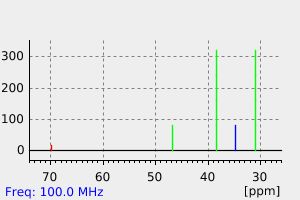1-氯双环[2.2.1]庚烷 | 765-67-3
中文名称
1-氯双环[2.2.1]庚烷
中文别名
——
英文名称
1-chlorobicyclo[2.2.1]heptane
英文别名
1-chlorobicyclo{2.2.1}heptane;1-chloronorbornane;1-chloro-norbornane;1-Chlor-norbornan
CAS
765-67-3
化学式
C7H11Cl
mdl
——
分子量
130.617
InChiKey
LKMFWORXBTXJNB-UHFFFAOYSA-N
BEILSTEIN
——
EINECS
——
-
物化性质
-
计算性质
-
ADMET
-
安全信息
-
SDS
-
制备方法与用途
-
上下游信息
-
文献信息
-
表征谱图
-
同类化合物
-
相关功能分类
-
相关结构分类
计算性质
-
辛醇/水分配系数(LogP):2.3
-
重原子数:8
-
可旋转键数:0
-
环数:2.0
-
sp3杂化的碳原子比例:1.0
-
拓扑面积:0
-
氢给体数:0
-
氢受体数:0
SDS
上下游信息
-
上游原料
中文名称 英文名称 CAS号 化学式 分子量 2,2-二氯双环[2.2.1]庚烷 2,2-dichloronorbornane 19916-65-5 C7H10Cl2 165.062
反应信息
-
作为反应物:描述:参考文献:名称:碳27.(9-烷基-9-芴基)-甲基锂(或铯)和2,2-二苯基-3,3-二甲基丁基锂的重排摘要:已经对将各种(9-烷基-9-芴基)甲基锂(或铯)化合物在THF中加热到接近0°C,然后进行碳化的产品进行了研究。当9-烷基为乙基时,结果主要是质子化产物(9-烷基-9-芴基)甲烷;当9-烷基为1-降冰片基时,显然会形成类似的产物。当9-烷基是叔丁基时,次要产物是叔[1,2]迁移引起的9-新戊基芴-9-羧酸。-氘基,而主要产物是分子内消除的9-甲基芴-9-羧酸,如氘标记所示。当9-烷基是新戊基时,主要产物是9-新戊基-9,10-二氢菲-9羧酸以及一些9-新戊基菲,其在35℃的乙醚溶液中成为主要产物。2,2-二苯基-3,3-二甲基丁基锂在0°C下主要在THF中经历[1,2]-苯基迁移。根据对9-叔丁基-9-(氯甲基)芴和9-新戊基-9-(氯甲基)芴的X射线晶体研究,可以得出结论,空间加速是导致(9-烷基-当9-烷基为叔丁基和新戊基时的9-芴基)甲基锂。DOI:10.1016/s0040-4020(01)90451-x
-
作为产物:描述:1-Norbornancarbonylchlorid 在 4-二甲氨基吡啶 、 二氟代氙 、 2-碘-1,1,1-三氟乙烷 、 2-mercaptopyridine-1-oxide sodium salt 作用下, 以 二氯甲烷 为溶剂, 反应 1.0h, 生成 1-氯双环[2.2.1]庚烷参考文献:名称:Synthesis of bridgehead fluorides by fluorodeiodination摘要:Fluorodeiodination is found to be an attractive procedure for the synthesis of bridgehead fluorides. Thus, treatment of the corresponding iodide with xenon difluoride in dichloromethane at ambient temperature generally leads to high yields of the fluoride. Evidence suggests the intermediacy of the bridgehead cation in this reaction, and accordingly the substrates which are unfavorably disposed to fluorodeiodination are the bicyclo[n.1.1]alkyl iodides. In this context the isolation of a small quantity of methyl 4-fluorobicyclo[2.1.1]hexane-1-carboxylate (46, R = COOMe) is significant because it represents the first occasion on which the elusive 1-bicyclo[2.1.1]hexyl cation has been trapped. We have also demonstrated that synthesis of the iodides themselves can be accomplished efficiently both by Barton halodecarboxylation and by treatment of the carboxylic acid with lead tetraacetate and iodine.DOI:10.1021/jo00036a018
文献信息
-
Bridgehead Carbocations via Carbene Fragmentation: Erasing a 10<sup>10</sup> Kinetic Preference作者:Robert A. Moss、Fengmei Zheng、Jean-Marie Fedé、Yan Ma、Ronald R. Sauers、John P. Toscano、Brett M. ShowalterDOI:10.1021/ja020002e日期:2002.5.1monitoring permitted the determination of the absolute rate constants for fragmentations of the carbenes in DCE at 25 degrees C. The rate constants (s(-1)) were: 1-NorOCCl (3.3 x 10(4)), 1-BcoOCCl (1.5 x 10(5)), and 1-AdOCCl (5.9 x 10(5)). The rate constants decreased in the order of increasing strain in the resulting bridgehead carbocation, but the range of rate constants was compressed to a factor of only1-降冰片氧基氯卡宾 (1-NorOCCl)、1-双环 [2.2.2] 辛氧基氯卡宾 (1-BcoOCCl) 和 1-金刚烷氧基氯卡宾 (1-AdOCCl) 在二氯乙烷 (DCE) 中通过适当的二氮丙啶光解生成。在每种情况下,唯一的产物是由卡宾碎裂为 [R(+) OC Cl(-)] 离子对、CO 损失和阳离子-阴离子塌陷形成的桥头烷基氯。在甲醇和 DCE 的混合物中,每种卡宾产生三种产物:RCl、ROH 和 ROMe。RCl 和 ROMe 是由离子对坍塌和甲醇捕获阳离子之间的竞争引起的。ROH 是由甲醇捕获卡宾(在碎裂之前)产生的,随后是 ROCH(Cl)OMe 的最终甲醇分解和水解。卡宾捕获与卡宾碎裂的比例依次为 1-NorOCCl > BcoOCCl > 1-AdOCCl;1-Nor(+) 是最不稳定的阳离子,并且断裂形成最慢,因此这种卡宾最容易被捕获。这种趋势在甲醇-戊烷混合物中更加
-
Bicyclo[2.2.1]heptan-1-ylcarbene can ring expand作者:Rebecca T. Ruck、Maitland JonesDOI:10.1016/s0040-4039(98)00840-5日期:1998.6Generation of bicyclo[2.2.1]heptan-1-ylcarbene from a hydrocarbon precursor avoids the problems that attend generation from nitrogenous molecules and allows the determination that such carbenes can ring expand to bridgehead alkenes.由烃前体产生双环[2.2.1]庚基-1-基卡宾避免了伴随含氮分子产生的问题,并使得可以确定此类碳烯可以环膨胀成桥头烯烃。
-
Preparation of Highly Reactive Lithium Metal Dendrites for the Synthesis of Organolithium Reagents作者:Michael P. Crockett、Lupita S. Aguirre、Leonel B. Jimenez、Han-Hsiang Hsu、Andy A. ThomasDOI:10.1021/jacs.2c07207日期:2022.9.14A long-standing problem in the area of organolithium chemistry has been the need for a highly reactive Li-metal source that mimics Li-powders but has the advantage of being freshly prepared from inexpensive and readily available Li-sources. Here, we report a simple and convenient activation method using liquid ammonia that furnishes a new Li-metal source in the form of crystalline Li-dendrites. The
-
Giese, Bernd; Stellmach, Joachim, Chemische Berichte, 1980, vol. 113, # 10, p. 3294 - 3302作者:Giese, Bernd、Stellmach, JoachimDOI:——日期:——
-
Nuclear spin-spin coupling via nonbonded interactions. 3. Importance of bridgehead interactions on vicinal carbon-13-proton and carbon-13-carbon-13 coupling constants in bicycloalkanes作者:M. Barfield、S. E. Brown、E. D. Canada、N. D. Ledford、J. L. Marshall、S. R. Walter、E. YakaliDOI:10.1021/ja00530a009日期:1980.5
表征谱图
-
氢谱1HNMR
-
质谱MS
-
碳谱13CNMR
-
红外IR
-
拉曼Raman
-
峰位数据
-
峰位匹配
-
表征信息
同类化合物
(5β,6α,8α,10α,13α)-6-羟基-15-氧代黄-9(11),16-二烯-18-油酸
(3S,3aR,8aR)-3,8a-二羟基-5-异丙基-3,8-二甲基-2,3,3a,4,5,8a-六氢-1H-天青-6-酮
(2Z)-2-(羟甲基)丁-2-烯酸乙酯
(2S,4aR,6aR,7R,9S,10aS,10bR)-甲基9-(苯甲酰氧基)-2-(呋喃-3-基)-十二烷基-6a,10b-二甲基-4,10-dioxo-1H-苯并[f]异亚甲基-7-羧酸盐
(1aR,4E,7aS,8R,10aS,10bS)-8-[((二甲基氨基)甲基]-2,3,6,7,7a,8,10a,10b-八氢-1a,5-二甲基-氧杂壬酸[9,10]环癸[1,2-b]呋喃-9(1aH)-酮
(+)顺式,反式-脱落酸-d6
龙舌兰皂苷乙酯
龙脑香醇酮
龙脑烯醛
龙脑7-O-[Β-D-呋喃芹菜糖基-(1→6)]-Β-D-吡喃葡萄糖苷
龙牙楤木皂甙VII
龙吉甙元
齿孔醇
齐墩果醛
齐墩果酸苄酯
齐墩果酸甲酯
齐墩果酸溴乙酯
齐墩果酸二甲胺基乙酯
齐墩果酸乙酯
齐墩果酸3-O-alpha-L-吡喃鼠李糖基(1-3)-beta-D-吡喃木糖基(1-3)-alpha-L-吡喃鼠李糖基(1-2)-alpha-L-阿拉伯糖吡喃糖苷
齐墩果酸 beta-D-葡萄糖酯
齐墩果酸 beta-D-吡喃葡萄糖基酯
齐墩果酸 3-乙酸酯
齐墩果酸 3-O-beta-D-葡吡喃糖基 (1→2)-alpha-L-吡喃阿拉伯糖苷
齐墩果酸
齐墩果-12-烯-3b,6b-二醇
齐墩果-12-烯-3,24-二醇
齐墩果-12-烯-3,21,23-三醇,(3b,4b,21a)-(9CI)
齐墩果-12-烯-3,21,23-三醇,(3b,4b,21a)-(9CI)
齐墩果-12-烯-3,11-二酮
齐墩果-12-烯-2α,3β,28-三醇
齐墩果-12-烯-29-酸,3,22-二羟基-11-羰基-,g-内酯,(3b,20b,22b)-
齐墩果-12-烯-28-酸,3-[(6-脱氧-4-O-b-D-吡喃木糖基-a-L-吡喃鼠李糖基)氧代]-,(3b)-(9CI)
齐墩果-12-烯-28-酸,3,7-二羰基-(9CI)
齐墩果-12-烯-28-酸,3,21,29-三羟基-,g-内酯,(3b,20b,21b)-(9CI)
鼠特灵
鼠尾草酸醌
鼠尾草酸
鼠尾草酚酮
鼠尾草苦内脂
黑蚁素
黑蔓醇酯B
黑蔓醇酯A
黑蔓酮酯D
黑海常春藤皂苷A1
黑檀醇
黑果茜草萜 B
黑五味子酸
黏黴酮
黏帚霉酸







